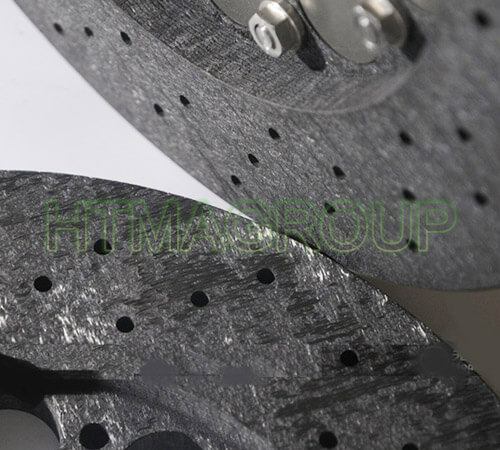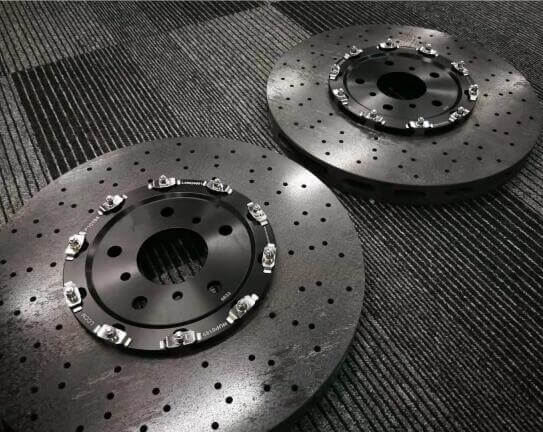We have examined friction performance, friction surface and chemistry of a carbon/silicon carbide ceramic (C/SiC) brake tested against an organic pad in air, and water spray environment. An average friction coefficient of 0.52 and 0.4 for a braking stop is achieved after bedding in air for a composite disc comprising 53.1% and 17.7% SiC/Si, respectively. It is identified that 100% SiC/Si and 50% Cf/C regions contribute the friction measurement. Tested in water spray, both brakes show a substantial fall of friction coefficient to a level <0.1. Evidences are

carbon ceramic composite
provided for the existence of hydrodynamic friction. Friction transfer materials removal, SiC region polishing, and lower real contact pressure reinforce hydrodynamic process that a ceramic composite brake can experience.
Carbon fiber reinforced carbon-silicon carbide (Cf/C-SiC), also called carbon/silicon carbide (C/SiC), ceramic composite has been progressively used as a replacement of cast iron for producing brake discs used in high performance cars since such application was successfully demonstrated more than a decade ago. By now, almost all commercial C/SiC brake discs are paired with pads that are made of so-called low metallic friction material (also called organic pad), a type of composite that all abrasives, lubricants are included to improve the wear resistance, thermal diffusivity and mechanical robustness. Organic pads themselves are widely used to pair with cast iron brake disc for a brake in a road vehicle. As known already, friction performance of a brake is highly sensible to the composite of such type of friction material. However, there is not yet sufficient tribological knowledge published about a friction pair that consists of C/SiC and low metallic friction material, whilst one may expect that extensive testing must have been done in industry to achieve/optimise the required friction performance of a carbon ceramic brakes, as noted by Krenkel in the early time.

carbon ceramic composite (C-SiC) brakes for racing car-3
In the past years, a number of papers have been published on the tribological performance of carbon ceramic composite tested against itself under specific testing conditions, aiming for self-mated friction application. In general, cracking damage induced by abrasion in the contract regions, and oxidation caused by friction heat are the essential tribological mechanisms that govern the friction performance of a brake and its variation with testing conditions. However, such knowledge can hardly be transferred and applied to a carbon ceramic disc paired with an organic pad, because the structure and chemistry of the friction contact regions are changed, leading to different chemical and mechanical processes involved in braking.
C/SiC composite brake disc was recently tested and studied against organic pads, and sintered metallic materials, on a testing car, full-scale dynamometer, or laboratory-scale dynamometer. The studies have demonstrated that testing results generated from laboratory-scale dynamometer can provide sufficient understanding for predicting what could happen for a brake tested on a testing car, or a full-scale dynamometer. It was found that, among all tests, there exists a clear bedding stage tha significant numbers of braking stop are needed for a brake to achieve a stable friction coefficient. Examination of friction surface has revealed that in general friction transfer layer is not easily deposited on the friction surface of a carbon ceramic disc with a strong bond. Based on such prior knowledge, we are further motivated to know how the variation of ceramic constituents in C/SiC composites would influence the friction coefficient at bedded stage, and the bedding process as well.
related news /articles:
Friction performance of C/SiC brakes in different environment (3)
Friction performance of C/SiC brakes in different environment (7)
Friction performance of C/SiC brakes in different environment (5)
Carbonized Organic Composites –CFCCARBON LTD